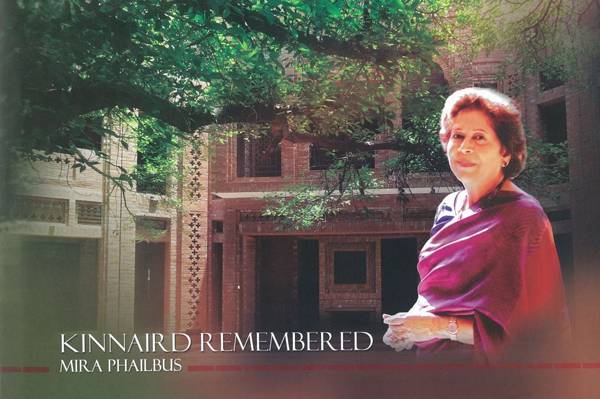
The red brick buildings of Kinnaird College have been a landmark on Jail Road since 1913. In Mira Phailbus’s words, it is one of those institutions that have “turned nightmares into dreams fulfilled.” It is a matter of celebration, then, to see the place turn hundred and have the occasion marked by the publishing of one of its most iconic Principals’ reminiscences. An elite institution set up by missionaries for girls, Kinnaird College boasts alumni of varying stature and fame. According to Mrs. Phailbus, it has egalitarian roots and is a non-commercial entity. She takes pride in the fact that it gives scholarships to worthy students from every background and polishes and prunes them to reach their full potential.
Mira Phailbus’s “Kinnaird Remembered” begins with the recollection of her bidding farewell to her predecessor and friend, Margaret Robinson - an occasion tinged with sadness and then, suddenly overshadowed by the arrival of a summons by Zulfiqar Ali Bhutto. The story of his imposition of an unwelcome and arbitrary education policy is told with great emotional detail and sets the tone for the author’s recounting of Kinnaird’s dramatic history. She recalls the pain of seeing the college come under the auspices of the government and the struggle to maintain its individuality. The problems faced are recounted in vivid detail, from the freezing of bank accounts when the institution was nationalized to the government’s attempts to impose uniforms on the students. The creative solutions devised to overcome these depict the college and its students’ resilience in the face of all odds.
[quote]Boys from Aitchison and Forman Christian College made it their business to climb Kinnaird's walls[/quote]
The book is peppered throughout with vignettes of the daily goings-on at the college. The author tells of amusing encounters with the opposite sex, something that goes with the territory of being an all-girls institution. In the beginning, the college walls were not very high or secure, which made them an easy target for all kinds of daredevils. Boys from Aitchison and Forman Christian College made it their business to climb over the walls or drive their motorbikes across the grounds as soon as the gates were opened, with guards and gardeners in hot pursuit. When the walls were finally raised, with the financial help of a government functionary, Ms. Phailbus was thoroughly amused to be requested not to divulge his name because he too had attempted such feats in his heyday and would not care to be remembered as the man who deprived subsequent generations of young men from such a rewarding pastime.
The author does not spare the daredevilry of girls either. She writes of numerous occasions of lost/eloped girls who were then hunted down and recovered before anything too awful happened. What shines through in these stories (not just of amorous misadventures but other disciplinary issues) is the institution and its Principal’s integrity in not allowing such miscreants back into the college, despite political and bureaucratic pressures that sometimes became almost impossible to withstand. And, every year when admission season rolled around, the same drama reenacted itself – parents frantic to have their daughters enrolled in one of the best institutions of the country called in favours from the highest possible patrons and engaged in every subterfuge they could think of, including fake domiciles in order to avail seats reserved for minorities or the underprivileged. For the ex-Principal, dealing with such problems in addition to her administrative responsibilities proved to be a challenge; one that she dealt with successfully, in the face of threats that, if carried out, might have ruined her career and would certainly have been an unfair blow to the institution.

Through stories like the ones mentioned above, interspersed with facts like the scholarships offered and services rendered to society, Mrs. Phailbus paints the college with a personality of its own. It comes across as a benevolent institution that integrates students from all walks of life and helps them achieve their true potential. She takes care also to highlight all the problems faced, especially in the financial department, which have made it difficult for it to give its girls all the facilities that other colleges take for granted.
Ms. Phailbus has a narrative style that might seem abrupt at times. However, most of the stories are interesting enough to capture the reader’s attention. They give an insight into the life and workings of Kinnaird, which have been the topic of society gossip since the college’s inception. Tales of boys breaking in and girls breaking out of the college have been a source of amusement and analysis for decades and hearing them from the lips of one of its most influential Principals will probably be a treat for many. The travails and pleasures of leading the institution, while juggling her personal life and being true to her work, are intertwined. Mrs. Phailbus is also diligent in recording the contributions of all levels of staff, from the servants to the professors; an act that lends a note of humility and honesty to the whole endeavor.
Mira Phailbus’s “Kinnaird Remembered” begins with the recollection of her bidding farewell to her predecessor and friend, Margaret Robinson - an occasion tinged with sadness and then, suddenly overshadowed by the arrival of a summons by Zulfiqar Ali Bhutto. The story of his imposition of an unwelcome and arbitrary education policy is told with great emotional detail and sets the tone for the author’s recounting of Kinnaird’s dramatic history. She recalls the pain of seeing the college come under the auspices of the government and the struggle to maintain its individuality. The problems faced are recounted in vivid detail, from the freezing of bank accounts when the institution was nationalized to the government’s attempts to impose uniforms on the students. The creative solutions devised to overcome these depict the college and its students’ resilience in the face of all odds.
[quote]Boys from Aitchison and Forman Christian College made it their business to climb Kinnaird's walls[/quote]
The book is peppered throughout with vignettes of the daily goings-on at the college. The author tells of amusing encounters with the opposite sex, something that goes with the territory of being an all-girls institution. In the beginning, the college walls were not very high or secure, which made them an easy target for all kinds of daredevils. Boys from Aitchison and Forman Christian College made it their business to climb over the walls or drive their motorbikes across the grounds as soon as the gates were opened, with guards and gardeners in hot pursuit. When the walls were finally raised, with the financial help of a government functionary, Ms. Phailbus was thoroughly amused to be requested not to divulge his name because he too had attempted such feats in his heyday and would not care to be remembered as the man who deprived subsequent generations of young men from such a rewarding pastime.
The author does not spare the daredevilry of girls either. She writes of numerous occasions of lost/eloped girls who were then hunted down and recovered before anything too awful happened. What shines through in these stories (not just of amorous misadventures but other disciplinary issues) is the institution and its Principal’s integrity in not allowing such miscreants back into the college, despite political and bureaucratic pressures that sometimes became almost impossible to withstand. And, every year when admission season rolled around, the same drama reenacted itself – parents frantic to have their daughters enrolled in one of the best institutions of the country called in favours from the highest possible patrons and engaged in every subterfuge they could think of, including fake domiciles in order to avail seats reserved for minorities or the underprivileged. For the ex-Principal, dealing with such problems in addition to her administrative responsibilities proved to be a challenge; one that she dealt with successfully, in the face of threats that, if carried out, might have ruined her career and would certainly have been an unfair blow to the institution.

Through stories like the ones mentioned above, interspersed with facts like the scholarships offered and services rendered to society, Mrs. Phailbus paints the college with a personality of its own. It comes across as a benevolent institution that integrates students from all walks of life and helps them achieve their true potential. She takes care also to highlight all the problems faced, especially in the financial department, which have made it difficult for it to give its girls all the facilities that other colleges take for granted.
Ms. Phailbus has a narrative style that might seem abrupt at times. However, most of the stories are interesting enough to capture the reader’s attention. They give an insight into the life and workings of Kinnaird, which have been the topic of society gossip since the college’s inception. Tales of boys breaking in and girls breaking out of the college have been a source of amusement and analysis for decades and hearing them from the lips of one of its most influential Principals will probably be a treat for many. The travails and pleasures of leading the institution, while juggling her personal life and being true to her work, are intertwined. Mrs. Phailbus is also diligent in recording the contributions of all levels of staff, from the servants to the professors; an act that lends a note of humility and honesty to the whole endeavor.

